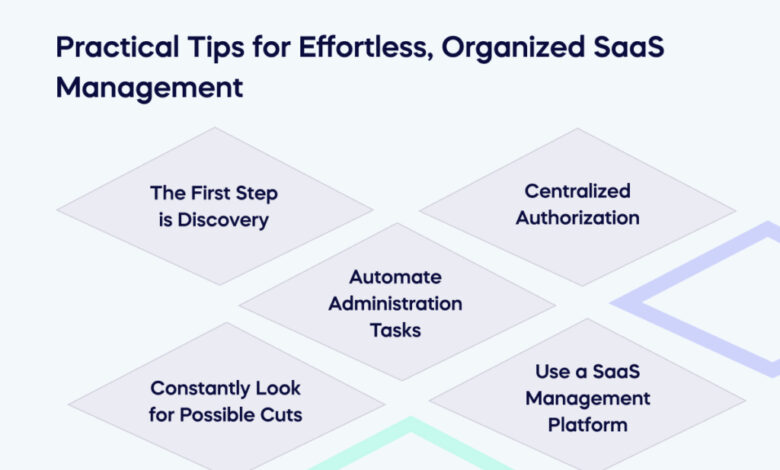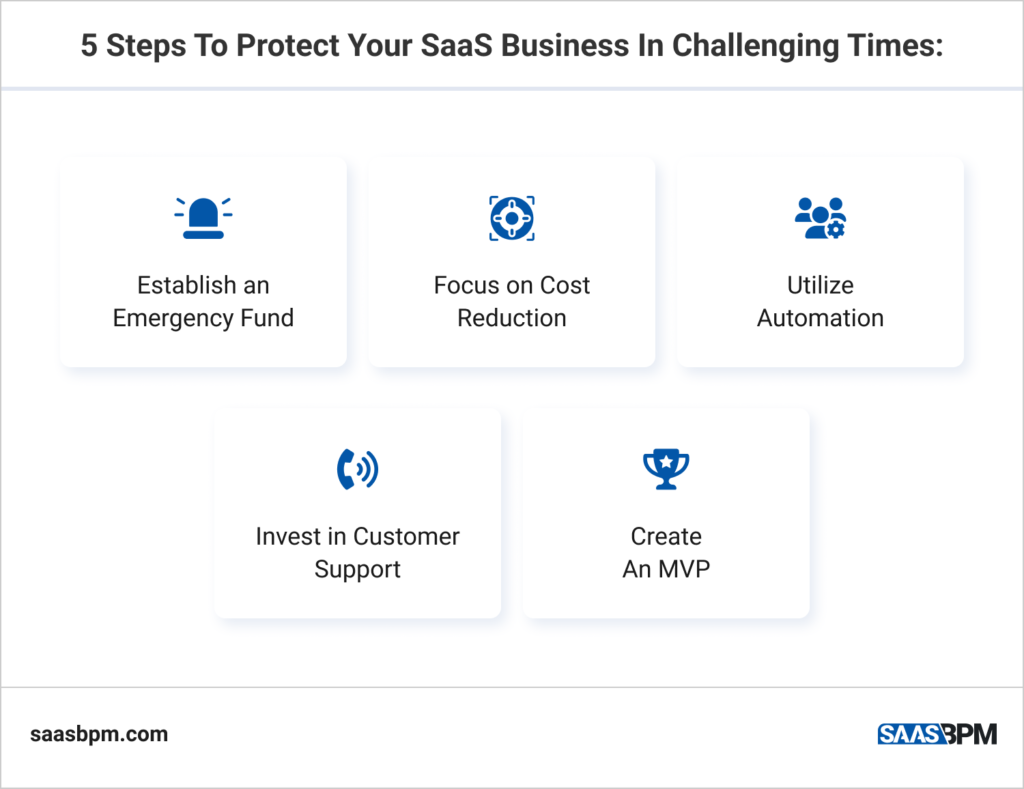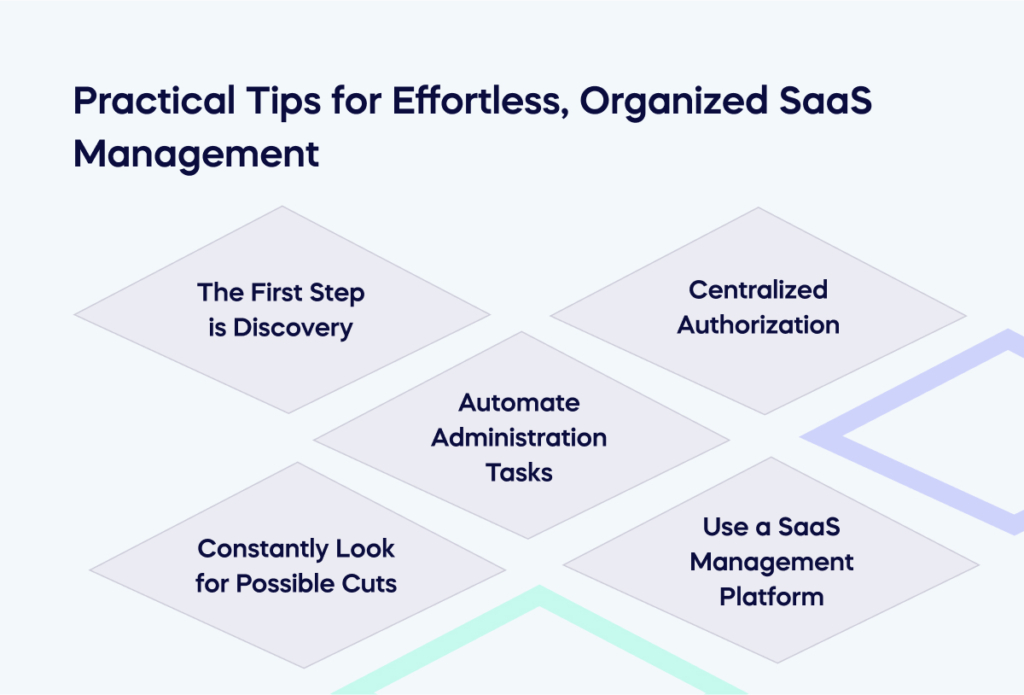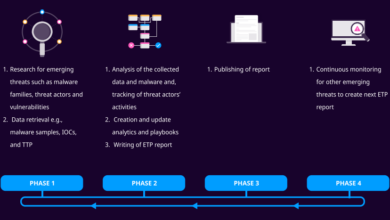
8 Tips to Protect Your Organization in the Evolving SaaS Landscape
8 Tips to Protect Your Organization in the Evolving SaaS Landscape: The world of Software as a Service (SaaS) is booming, offering incredible efficiency and flexibility. But this convenience comes with a growing set of security challenges. From sophisticated phishing attacks to increasingly complex data breaches, protecting your organization in this dynamic environment requires a proactive and multi-faceted approach.
This post will delve into eight essential strategies to bolster your SaaS security posture and safeguard your valuable data.
We’ll cover everything from implementing robust access controls and understanding vendor risks to establishing comprehensive incident response plans and staying ahead of emerging threats. Think of this as your essential guide to navigating the complexities of SaaS security and building a resilient defense against the ever-evolving threat landscape. Get ready to learn how to protect your business in the cloud!
Understanding SaaS Security Risks in the Modern Landscape

The shift to cloud-based SaaS applications has revolutionized how businesses operate, offering unparalleled flexibility and scalability. However, this transition also introduces a new set of security challenges. The modern SaaS threat landscape is dynamic and constantly evolving, requiring organizations to adopt proactive and adaptable security strategies. Understanding these risks is the first crucial step towards effective protection.The increasing reliance on SaaS applications exposes organizations to a broader range of vulnerabilities and attack vectors than traditional on-premise systems.
This is largely due to the shared responsibility model inherent in SaaS, where the vendor manages the underlying infrastructure, but the customer remains responsible for data security and application configuration. This shared responsibility can create confusion and gaps in security coverage, leaving organizations vulnerable.
Common SaaS Security Risks
The following table categorizes common SaaS security risks, their impact, and potential mitigation strategies. Understanding these risks is critical for developing a comprehensive security posture.
| Risk Type | Description | Impact | Mitigation Strategy |
|---|---|---|---|
| Data Breaches | Unauthorized access to sensitive data stored within the SaaS application, often due to vulnerabilities, weak access controls, or insider threats. | Financial losses, reputational damage, legal penalties, loss of customer trust, and regulatory fines (e.g., GDPR). | Implement robust access controls, data encryption both in transit and at rest, regular security audits, and employee training on data security best practices. Utilize data loss prevention (DLP) tools. |
| Account Takeovers | Compromise of user accounts, granting attackers access to sensitive data and functionalities within the SaaS application. Often achieved through phishing attacks, credential stuffing, or exploiting weak passwords. | Data breaches, unauthorized modifications, disruption of services, and potential for lateral movement within the organization’s network. | Enforce strong password policies, implement multi-factor authentication (MFA), regularly monitor user activity for suspicious behavior, and conduct security awareness training to educate users about phishing scams. |
| Misconfigurations | Improperly configured SaaS applications, exposing sensitive data or functionalities to unauthorized access. This can include insecure default settings, overly permissive access controls, or lack of proper encryption. | Data breaches, unauthorized access, service disruptions, and compliance violations. | Regularly review and update SaaS application configurations, utilize configuration management tools, and implement automated security checks. Engage in thorough security assessments upon initial SaaS implementation and regularly thereafter. |
| API Vulnerabilities | Exploitable weaknesses in the application programming interfaces (APIs) used by SaaS applications, allowing attackers to gain unauthorized access or manipulate data. | Data breaches, unauthorized modifications, denial-of-service attacks, and potential for further compromise of connected systems. | Regularly scan APIs for vulnerabilities, implement robust authentication and authorization mechanisms, and utilize API gateways with security features like rate limiting and input validation. |
| Third-Party Risks | Security vulnerabilities within third-party applications or services integrated with the SaaS application. | Compromise of the entire system, data breaches, and disruption of services. | Carefully vet third-party vendors, conduct regular security assessments of integrated applications, and enforce strict security requirements in contracts. |
Challenges of Multi-Tenant SaaS Architectures
Multi-tenant architectures, while offering cost efficiencies, present unique security challenges. The shared infrastructure means that a security breach in one tenant’s environment could potentially impact other tenants. Effective isolation between tenants is paramount. This requires robust security controls and monitoring to prevent data leakage or unauthorized access between different tenants. For example, a poorly implemented multi-tenancy model might allow an attacker who compromises one user account to access data from other users within the same SaaS application.
This highlights the need for strong tenant isolation mechanisms and granular access controls. Furthermore, the shared responsibility model can make it difficult to pinpoint accountability in case of a security incident.
Implementing Strong Access Control and Authentication
Securing your SaaS applications requires a robust approach to access control and authentication. In today’s threat landscape, simply relying on passwords is insufficient. A multi-layered security strategy, incorporating strong authentication methods and granular access permissions, is crucial for protecting your organization’s sensitive data and maintaining operational integrity. This involves implementing multi-factor authentication (MFA), enforcing the principle of least privilege, and leveraging effective Identity and Access Management (IAM) solutions.Implementing multi-factor authentication (MFA) across all SaaS applications significantly reduces the risk of unauthorized access, even if credentials are compromised.
MFA adds an extra layer of security by requiring users to verify their identity through multiple factors, such as something they know (password), something they have (phone or security key), and something they are (biometrics). This makes it exponentially harder for attackers to gain access, even if they have obtained a username and password.
Multi-Factor Authentication Best Practices, 8 tips to protect your organization in the evolving saas landscape
Effective MFA implementation requires careful planning and execution. Choosing the right MFA method depends on your organization’s specific security needs and risk tolerance. Consider offering a variety of MFA options to accommodate different user preferences and device capabilities. For example, time-based one-time passwords (TOTP) using authenticator apps are a popular and readily available option. Hardware security keys provide a higher level of security, while biometric authentication offers convenience and strong security.
Regularly review and update your MFA policies to reflect evolving security threats and best practices. Ensure that your MFA implementation integrates seamlessly with your existing SaaS applications and doesn’t hinder user productivity. For example, consider the user experience and the impact on workflows. A poorly implemented MFA system can lead to user frustration and ultimately, reduced security effectiveness as users find ways to circumvent the process.
Least Privilege Access in SaaS Environments
The principle of least privilege dictates that users should only have access to the minimum resources and data necessary to perform their job functions. This significantly limits the potential damage from a security breach or insider threat. In a SaaS environment, enforcing least privilege requires granular control over user permissions and roles. This can be achieved through role-based access control (RBAC) which allows administrators to define roles with specific permissions and assign those roles to users.
Regularly review and audit user permissions to ensure they remain appropriate. Removing unnecessary access rights reduces the attack surface and minimizes the risk of data breaches. Automated tools can help streamline this process and ensure consistent enforcement of least privilege across your SaaS applications. For instance, regularly scheduled permission reviews coupled with automated alerts for unusual access patterns can be highly effective.
Effective Identity and Access Management (IAM) Solutions for SaaS
Many SaaS providers offer built-in IAM capabilities, but dedicated IAM solutions provide more comprehensive control and visibility across multiple SaaS applications. These solutions often include features like single sign-on (SSO), which allows users to access multiple applications with a single set of credentials, simplifying access and improving security. They also typically offer advanced features like access governance, auditing, and reporting capabilities.
Examples of such solutions include Okta, Azure Active Directory, and Ping Identity. These platforms provide centralized management of user identities and access rights, simplifying administration and improving security posture. When selecting an IAM solution, consider factors such as scalability, integration capabilities, and the level of support provided. The solution should seamlessly integrate with your existing infrastructure and provide the necessary tools to manage user access effectively across your SaaS ecosystem.
Data Security and Privacy Best Practices in SaaS
Securing your organization’s data within the SaaS environment is paramount. The shared responsibility model inherent in SaaS means both the vendor and the organization share accountability for data protection. Understanding and implementing robust security practices is crucial to mitigating risks and ensuring compliance. This section delves into practical strategies for safeguarding sensitive data stored in SaaS applications.Data security and privacy in SaaS requires a multi-layered approach, combining technical safeguards with strong policies and procedures.
Effective strategies leverage encryption, data loss prevention (DLP) tools, and regular security assessments to minimize vulnerabilities and protect sensitive information. Compliance with relevant regulations like GDPR and CCPA is also critical.
SaaS Data Encryption Methods
Encryption is a cornerstone of data security. At rest encryption protects data stored on the SaaS provider’s servers, while in-transit encryption safeguards data as it travels between your organization and the SaaS application. Many SaaS providers offer both types of encryption, but it’s vital to verify their implementation and strength. For example, AES-256 is a widely accepted standard for strong encryption.
Consider the encryption of data both at rest and in transit. The use of strong encryption algorithms like AES-256 is crucial. Regular key rotation further enhances security.
Data Loss Prevention (DLP) Techniques in SaaS
Data Loss Prevention (DLP) techniques are essential to prevent sensitive data from leaving your organization’s control. DLP solutions can monitor data movement, identify sensitive information, and block unauthorized transfers. These solutions can be integrated with your SaaS applications to monitor emails, file uploads, and other data transfer methods. Implementing DLP measures should include identifying and classifying sensitive data, configuring DLP rules based on data sensitivity, and regularly reviewing and updating these rules to adapt to evolving threats.
Examples of DLP techniques include data masking, access control lists, and network monitoring.
Conducting a Comprehensive SaaS Data Security Assessment
A comprehensive SaaS data security assessment involves a systematic evaluation of your organization’s SaaS usage and its associated risks. This assessment should be conducted regularly and includes the following steps:
- Inventory SaaS Applications: Create a complete list of all SaaS applications used by your organization, including their functionalities and data storage locations.
- Risk Assessment: Identify potential security risks associated with each application, considering factors like data sensitivity, access controls, and vendor security practices.
- Vulnerability Scanning: Utilize automated tools to scan SaaS applications for known vulnerabilities and weaknesses.
- Penetration Testing: Simulate real-world attacks to identify exploitable vulnerabilities and assess the effectiveness of security controls.
- Vendor Due Diligence: Review the security practices and certifications of your SaaS providers, ensuring they meet your organization’s security requirements.
- Policy Review: Assess the adequacy of your organization’s data security policies and procedures regarding SaaS usage.
- Employee Training: Evaluate the effectiveness of employee training programs on SaaS security best practices.
- Incident Response Plan: Ensure you have a well-defined incident response plan in place to handle data breaches or security incidents.
Compliance with GDPR, CCPA, and Other Regulations
Compliance with data privacy regulations like GDPR and CCPA is crucial when using SaaS applications. These regulations impose stringent requirements on how organizations collect, process, and protect personal data. To ensure compliance, organizations should:
- Data Mapping: Identify and map all personal data processed through SaaS applications.
- Data Minimization: Collect and process only the minimum necessary personal data.
- Data Subject Rights: Implement procedures to handle data subject access requests, rectification requests, and data erasure requests.
- Data Breach Notification: Establish procedures for notifying relevant authorities and data subjects in case of a data breach.
- Vendor Contracts: Include data protection clauses in contracts with SaaS providers, ensuring they meet regulatory requirements.
Vendor Risk Management for SaaS Applications
Choosing the right SaaS vendor is crucial for your organization’s security. A poorly vetted vendor can expose your sensitive data and disrupt your operations. Effective vendor risk management is therefore not just a best practice, but a necessity in today’s interconnected world. This involves a thorough evaluation of a vendor’s security posture before, during, and after onboarding.Vendor risk management frameworks provide a structured approach to assessing and mitigating potential risks associated with third-party vendors.
These frameworks often involve a combination of questionnaires, security assessments, and ongoing monitoring. A well-defined process helps organizations identify and address potential vulnerabilities proactively, minimizing the impact of security breaches.
SaaS Vendor Security Posture Evaluation Checklist
Before onboarding a new SaaS vendor, a comprehensive evaluation is essential. This checklist focuses on key security aspects to ensure alignment with your organization’s risk tolerance. Remember that this checklist is a starting point; your specific requirements may vary depending on your industry and the sensitivity of your data.
- Security certifications and compliance: Does the vendor hold relevant certifications such as ISO 27001, SOC 2, or HIPAA compliance? Verification of these certifications provides assurance of adherence to industry-standard security practices.
- Data security practices: What encryption methods does the vendor use for data at rest and in transit? How does the vendor handle data backups and disaster recovery? Understanding these aspects ensures your data is protected against unauthorized access and loss.
- Access control and authentication: What authentication methods does the vendor support (e.g., multi-factor authentication)? How does the vendor manage user access and permissions? Robust access control minimizes the risk of unauthorized access and data breaches.
- Incident response plan: Does the vendor have a documented incident response plan? What are their procedures for handling security incidents and data breaches? A well-defined plan ensures swift and effective response to potential security threats.
- Third-party risk management: Does the vendor have a process for managing the risks associated with their own third-party vendors? Understanding their approach to managing their supply chain helps to ensure the overall security of your data.
- Physical security: If applicable, what physical security measures does the vendor implement to protect their data centers and infrastructure? This is particularly important for vendors managing on-premise infrastructure.
- Vulnerability management: How does the vendor identify and address vulnerabilities in their systems and applications? Regular vulnerability scanning and patching are crucial for preventing exploitation.
- Data residency and sovereignty: Where is your data stored and processed? Does this comply with relevant regulations and your organization’s policies? This is critical for organizations subject to data sovereignty requirements.
Comparison of Vendor Risk Management Frameworks
Several frameworks guide vendor risk management, each with its strengths and weaknesses. Choosing the right framework depends on your organization’s size, industry, and risk appetite.
- NIST Cybersecurity Framework: A widely adopted framework providing a comprehensive approach to managing cybersecurity risks. It emphasizes a risk-based approach, focusing on identifying, assessing, and mitigating risks.
- ISO 27001: An internationally recognized standard for information security management systems. It provides a framework for establishing, implementing, maintaining, and continually improving an information security management system.
- COBIT: A framework for IT governance and management. It provides a holistic approach to managing IT risks, including those associated with third-party vendors.
Key Due Diligence Questions for SaaS Vendors
Asking the right questions during the vendor selection process is critical. The following table Artikels key areas of inquiry and expected responses.
| Question Category | Specific Question | Importance | Expected Response Type |
|---|---|---|---|
| Security Certifications | What security certifications and compliance standards does your organization hold? | High | List of certifications (e.g., ISO 27001, SOC 2, HIPAA) and compliance statements. |
| Data Security | What encryption methods are used for data at rest and in transit? | High | Specific encryption algorithms and key management practices. |
| Access Control | What authentication methods are supported, and what access control mechanisms are in place? | High | Description of authentication methods (e.g., MFA), role-based access control (RBAC), and other access control measures. |
| Incident Response | What is your incident response plan, and how will you notify us in case of a security breach? | High | Detailed description of the incident response plan, including communication protocols. |
| Data Privacy | How do you comply with data privacy regulations (e.g., GDPR, CCPA)? | High | Description of data privacy practices and compliance measures. |
| Vulnerability Management | What is your process for identifying and addressing vulnerabilities in your systems? | Medium | Description of vulnerability scanning and patching procedures. |
| Third-Party Risk Management | How do you manage the security risks associated with your own third-party vendors? | Medium | Description of the vendor risk management program. |
| Physical Security | What physical security measures are in place to protect your data centers and infrastructure? (If applicable) | Medium | Description of physical security controls, such as access controls, surveillance, and environmental controls. |
Regular Security Monitoring and Auditing of SaaS
Proactive security monitoring and regular audits are crucial for maintaining the integrity and confidentiality of your organization’s data residing within SaaS applications. Failing to implement these practices leaves your organization vulnerable to breaches, data loss, and compliance violations. A robust security posture requires a multi-faceted approach that combines continuous monitoring with periodic, in-depth audits.Continuous monitoring of SaaS applications involves actively tracking user activity, system logs, and security events for any anomalies or suspicious behavior.
This proactive approach allows for swift identification and response to potential threats before they escalate into major incidents. Regular security audits, on the other hand, provide a more comprehensive, in-depth review of your SaaS security posture, identifying vulnerabilities and weaknesses that might be missed by continuous monitoring alone. The combination of both ensures a layered defense strategy.
So, you’re diving into those 8 tips to protect your organization in the evolving SaaS landscape? Smart move! A key part of that strategy involves building secure and adaptable internal systems, which is where understanding the power of domino app dev, the low-code and pro-code future , comes in. Leveraging these modern development approaches helps create robust, secure apps that enhance your overall SaaS security posture, making those 8 tips even more effective.
Continuous Monitoring of SaaS Applications
Implementing continuous monitoring involves integrating various security tools and techniques to track and analyze activity within your SaaS applications. This includes leveraging the security features offered by the SaaS providers themselves, as well as deploying dedicated security information and event management (SIEM) systems. Key aspects include real-time log analysis, user behavior analytics, and anomaly detection. Effective monitoring requires establishing baselines of normal activity to better identify deviations.
For example, a sudden surge in login attempts from unusual geographical locations would immediately trigger an alert. Similarly, unusual data access patterns, such as a large volume of data downloaded by a single user in a short period, could indicate a potential data exfiltration attempt.
Regular Security Audits of SaaS Usage
Regular security audits provide a more in-depth assessment of your organization’s SaaS security posture. These audits typically involve a combination of automated scans and manual reviews of configurations, access controls, and data security practices. The frequency of these audits depends on your organization’s risk tolerance and the sensitivity of the data stored in SaaS applications. A good starting point might be annual audits, supplemented by more frequent assessments for critical applications.
During these audits, security professionals will review access control lists, encryption policies, and data retention policies, ensuring they align with your organization’s security standards and compliance requirements. They’ll also assess the vendor’s security posture and compliance certifications.
Examples of SIEM Tools for SaaS Monitoring
Several SIEM tools are well-suited for monitoring SaaS environments. These tools aggregate security logs from various sources, including SaaS applications, cloud infrastructure, and on-premises systems, providing a centralized view of your organization’s security posture. Examples include Splunk, IBM QRadar, and Azure Sentinel. These platforms offer features such as real-time log analysis, threat detection, and security incident response capabilities.
For instance, Splunk can be configured to monitor logs from Salesforce, Microsoft 365, and other SaaS applications, alerting security teams to suspicious activity like unauthorized access attempts or data breaches. The choice of SIEM tool will depend on factors such as the size and complexity of your organization’s IT infrastructure and budget. A thorough evaluation of different options is recommended before making a decision.
Employee Training and Awareness for SaaS Security
Protecting your organization’s data in the SaaS landscape isn’t just about robust technology; it’s about empowering your employees to be the first line of defense. A comprehensive security awareness program is crucial, transforming your workforce from potential vulnerabilities into active participants in safeguarding sensitive information. This involves consistent training, engaging communication, and integrating security into the very fabric of your company culture.Employee training isn’t a one-time event; it’s an ongoing process of education and reinforcement.
Regular updates and refresher courses are vital to keep employees abreast of evolving threats and best practices. Furthermore, a successful program must go beyond simple compliance and foster a proactive security mindset.
A Sample SaaS Security Training Module
This module focuses on practical application and real-world scenarios. The training should include interactive elements like quizzes and simulated phishing attacks to reinforce learning and encourage active participation.
Module 1: Understanding SaaS Security Risks
This section covers the basics of SaaS security, including common threats like phishing, malware, and data breaches. It emphasizes the importance of strong passwords and the dangers of clicking on suspicious links or attachments.
Example: A simulated phishing email will be presented, illustrating a typical phishing attack. Employees will be asked to identify the warning signs and explain why it’s a phishing attempt. The training will then explain how to report such emails to the IT department.
Module 2: Secure SaaS Usage Practices
This section details best practices for using SaaS applications securely. This includes topics such as: using strong and unique passwords for each account, enabling multi-factor authentication (MFA) wherever possible, recognizing and avoiding phishing attempts, understanding the importance of data encryption, and being cautious about sharing sensitive information online.
Example: A scenario involving a social engineering attack will be presented. Employees will be asked to identify the vulnerabilities exploited and suggest ways to prevent similar attacks. The training will then discuss strategies for handling such situations and emphasize the importance of reporting suspicious activity immediately.
Module 3: Recognizing and Reporting Security Incidents
This section Artikels the procedure for reporting security incidents, emphasizing the importance of timely reporting and the steps to take if a breach is suspected. It includes contact information for the IT security team and a clear explanation of the escalation process.
Example: A case study of a real-world data breach will be presented, analyzing the root cause, impact, and lessons learned. Employees will be encouraged to discuss their experiences and share best practices.
Key Elements of a Successful SaaS Security Awareness Program
A successful program requires a multi-faceted approach that goes beyond simply delivering training materials. It needs ongoing reinforcement, consistent communication, and measurable results.
Regular training sessions, tailored to different roles and responsibilities within the organization, are essential. The training should be engaging and relevant to employees’ daily work tasks, using real-world examples and interactive exercises. Feedback mechanisms, such as surveys and quizzes, help assess understanding and identify areas needing improvement. Finally, a strong communication strategy is crucial, ensuring consistent messaging across all channels and keeping employees informed about emerging threats.
Incorporating Security Awareness Training into Onboarding
Integrating security awareness training into the onboarding process for new employees is paramount. This ensures that security best practices are instilled from day one, reducing the risk of human error.
New hires should receive comprehensive training on the organization’s security policies, procedures, and the specific SaaS applications they’ll be using. This should include practical exercises and simulations to help them understand and apply the concepts learned. Furthermore, this initial training should be reinforced with regular refresher courses and updates throughout their employment.
Incident Response Planning for SaaS Security Breaches: 8 Tips To Protect Your Organization In The Evolving Saas Landscape

A robust incident response plan is crucial for minimizing the damage and downtime caused by a SaaS security breach. Without a pre-defined plan, organizations risk reacting chaotically, potentially exacerbating the situation and prolonging recovery. A well-structured plan ensures a coordinated and efficient response, safeguarding sensitive data and maintaining business continuity.A comprehensive incident response plan for SaaS security incidents should detail the steps to be taken from initial detection to full recovery and post-incident analysis.
This plan should be regularly tested and updated to reflect changes in the organization’s SaaS environment and evolving threat landscapes. Ignoring this critical aspect can lead to significant financial losses, reputational damage, and legal repercussions.
Incident Response Plan Steps
A step-by-step incident response plan should cover several key phases. The plan needs to be easily accessible to all relevant personnel and clearly define roles and responsibilities. Consider using a flowchart or similar visual aid to improve understanding and streamline the response process. The plan should also integrate with existing incident response plans covering other aspects of the organization’s IT infrastructure.
- Preparation: This phase involves identifying potential vulnerabilities, defining roles and responsibilities, establishing communication channels, and creating a list of essential contacts (e.g., legal counsel, law enforcement, public relations). It also includes regular security awareness training for employees and the development of playbooks for common incident scenarios.
- Detection and Analysis: This stage involves identifying the security breach, determining its scope and impact, and gathering evidence. This may involve analyzing security logs, network traffic, and user activity.
- Containment: The focus here is on limiting the spread of the breach. This could involve isolating affected systems, blocking malicious actors, and restricting access to sensitive data. A critical component is disabling compromised accounts immediately.
- Eradication: This step focuses on removing the root cause of the breach, such as malware or compromised credentials. This may involve reinstalling software, patching vulnerabilities, and implementing stronger security controls.
- Recovery: This involves restoring affected systems and data to a secure state. This may include using backups, restoring data from a disaster recovery site, or employing other data recovery methods. Verification of data integrity is paramount.
- Post-Incident Activity: This phase involves analyzing the incident to identify its root cause, improving security controls to prevent future incidents, and documenting lessons learned. This is crucial for continuous improvement of the organization’s security posture.
Roles and Responsibilities During a SaaS Security Breach
Clearly defined roles and responsibilities are essential for effective incident response. Ambiguity can lead to delays and confusion during a crisis. Each role should have specific tasks and responsibilities Artikeld in the incident response plan. Regular training and drills will ensure that personnel are prepared to act effectively under pressure.
| Role | Responsibilities |
|---|---|
| Incident Response Team Leader | Oversees the entire incident response process, coordinating the activities of various teams and ensuring effective communication. |
| Security Analyst | Investigates the security breach, analyzes logs and evidence, and identifies the root cause. |
| System Administrator | Contains the breach, isolates affected systems, and restores services. |
| Legal Counsel | Advises on legal implications and compliance requirements. |
| Public Relations | Manages communication with stakeholders, including customers, employees, and the media. |
Containing and Remediating a SaaS Security Incident
Containing and remediating a SaaS security incident requires swift and decisive action. The speed and effectiveness of the response directly impact the extent of the damage. Immediate actions should focus on isolating affected systems and preventing further compromise. Data recovery methods should be pre-planned and tested regularly to ensure a quick and efficient restoration process.
Methods for containing a breach might include disabling user accounts, revoking API keys, blocking malicious IP addresses, and implementing temporary access restrictions. Remediating the breach involves identifying and removing malware, patching vulnerabilities, and implementing stronger security controls. Data recovery might involve restoring from backups, using a disaster recovery site, or employing data recovery tools. Communication strategies should be pre-defined and include plans for notifying affected parties, the public, and regulatory bodies as appropriate.
Transparency and timely communication are crucial for mitigating reputational damage.
Staying Ahead of the Curve
The SaaS landscape is in constant flux, with new applications, features, and threats emerging regularly. Successfully navigating this environment requires a proactive and adaptable security posture. Failing to keep pace with evolving threats can leave organizations vulnerable to significant breaches and financial losses. This section focuses on strategies to anticipate and mitigate emerging SaaS security risks.The ability to predict and respond to emerging threats is crucial for maintaining a strong security posture in the SaaS environment.
This requires a combination of technological advancements, diligent monitoring, and a commitment to continuous learning and improvement. Ignoring this dynamic aspect of SaaS security can lead to significant vulnerabilities and expose organizations to potentially devastating consequences.
Emerging SaaS Threats and Mitigation Strategies
Organizations must actively identify and address emerging threats. This includes staying informed about newly discovered vulnerabilities in popular SaaS platforms, keeping abreast of evolving attack vectors like sophisticated phishing campaigns targeting SaaS login credentials, and understanding the security implications of integrating new SaaS applications into existing IT infrastructures. Proactive mitigation strategies involve implementing robust security information and event management (SIEM) systems to detect anomalous activity, regularly patching and updating SaaS applications, and employing multi-factor authentication (MFA) for all user accounts.
For example, the rise of AI-powered phishing attacks necessitates the use of advanced threat detection tools capable of identifying subtle anomalies in email communications.
Maintaining Up-to-Date SaaS Security Best Practices
Staying current on the latest SaaS security best practices and technologies is paramount. This requires a multi-pronged approach, including subscribing to security advisories from SaaS vendors, participating in industry events and webinars, and engaging with security communities and experts. Organizations should regularly review their existing security policies and procedures to ensure they align with the latest best practices.
For instance, the adoption of zero-trust security models, which verify every access request regardless of its origin, is becoming increasingly important in mitigating the risks associated with cloud-based applications. Failure to adapt to these changes could leave organizations exposed to known vulnerabilities that have already been addressed by the industry.
Establishing a Continuous Improvement Process
A continuous improvement process is essential for maintaining a robust SaaS security posture. This involves regularly assessing the organization’s security controls, identifying areas for improvement, and implementing changes to enhance protection. This process should include regular security audits, penetration testing, and vulnerability assessments. Establishing a feedback loop, where security incidents and near-misses are analyzed and used to inform future improvements, is crucial.
For example, following a successful phishing attack, an organization might implement additional security awareness training and strengthen its MFA policies to prevent similar incidents in the future. The continuous improvement cycle is not a one-time event; it is an ongoing process that requires dedication and resources.
Final Conclusion

Securing your organization in the SaaS landscape isn’t a one-time fix; it’s an ongoing journey. By consistently implementing these eight tips, regularly reviewing your security posture, and adapting to emerging threats, you can significantly reduce your risk profile and build a more resilient organization. Remember, proactive security is the best defense, and continuous learning is key to staying ahead of the curve in the ever-changing world of SaaS.
Don’t wait for a breach – take control of your security today!
Question Bank
What is multi-factor authentication (MFA) and why is it crucial for SaaS security?
MFA adds an extra layer of security beyond just a password. It requires multiple forms of verification (like a password and a code from your phone) to access an account, making it much harder for unauthorized users to gain access, even if they obtain your password.
How often should I conduct security audits of my SaaS applications?
The frequency depends on your risk tolerance and the sensitivity of your data. At a minimum, annual audits are recommended, but more frequent reviews (e.g., quarterly or even monthly) are advisable for high-risk applications or those handling sensitive customer information.
What are some common signs of a SaaS security breach?
Unusual login attempts from unfamiliar locations, unexpected email activity, unexplained data loss, performance degradation, and security alerts from your SaaS providers are all potential indicators of a breach.
What should I do if I suspect a SaaS security breach?
Immediately follow your organization’s incident response plan. This usually involves isolating affected systems, investigating the breach, containing the damage, and notifying relevant parties (including affected users and authorities if necessary).





